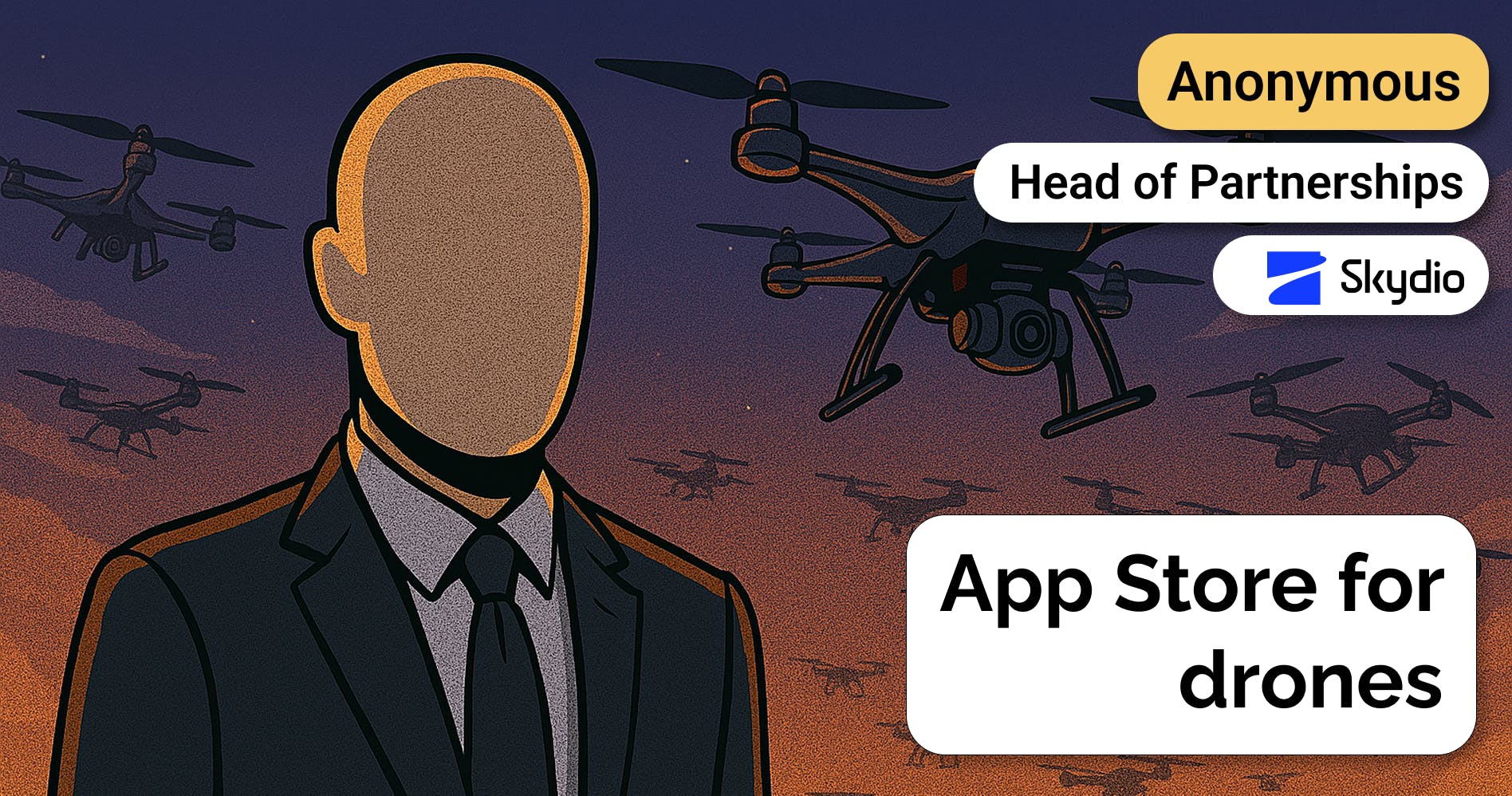Director of UAS Operations at NV5 on navigating the DJI ban to build a compliant drone fleet
 Jan-Erik Asplund
Jan-Erik Asplund

Background
NV5 Global (NASDAQ: NVEE) is a $1B+ engineering and geospatial services firm that provides drone-based inspection and surveying to utilities like PG&E and SCE.
We spoke with a Director of Unmanned Flight Operations at NV5 to understand how political pressure and regulation are reshaping the drone supply chain, what buyers want from drone vendors today, and how AI is shifting the economics of utility-scale inspections.
Key points via Sacra AI:
- U.S.-China tension has created a premium domestic drone market virtually overnight: Customers across the commercial drone value-chain, not just government customers, are banning DJI, yet alternatives still fall short of DJI-class performance with substitutes from Freefly or Skydio at ASPs 2x or 3x higher than DJI while under-delivering on sensor quality, zoom and flight time. DJI is effectively banned via a “blue list” which sets guidelines for government drone purchases, and “green list” geared to commercial use cases, though even some commercial customers prefer sticking to the stricter blue list. The bans and resulting capability-price gap has opened a window for new entrants from the US or Europe that can marry compliant supply chains with performance.
- Software and AI are already slashing post-flight imagery- and data-analysis costs, and the gains mean end customers can process data from flights much more quickly and cheaply than in the past, upping throughput and potentially — demand for hardware, sensors, and flight services: A single utility (SCE) went from 30 full-time image reviewers to almost none in five years by rolling out an in-house AI pipeline. Now humans only spot-check the algorithm’s flags. The demand for flights grew because AI made it less painful to ingest 20K to 30K images per inspection cycle.
- Large engineering-services firms and smaller contractors play a key part in the UAS value chain, purchasing drones in order to then provide services to commercial and government customers, which often prefer to outsource UAS-purchasing and piloting given their demand for UAS flights is bursty rather than routine and predictable. Utilities — e.g. PG&E, Southern California Edison, National Grid — and oil-pipeline operators routinely sign drone-services deals at $1M+ ACVs with multiple contractors, preferring to have a rotating set of providers rather than relying too heavily on a single contractor. That said, new autonomy capabilities, easier controls, and “drone-in-a-box” systems where UASs deploy and land themselves require less expertise to operate, solving problems with drone crashes that marred internal deployments in the past. This trend could lead to more in-housing of drone hardware and flights in the future.
- Large drone-service providers like engineering firm NV5, typically require 20+ drones to service large contracts with utilities, and estimate a 2- to 3-year lifecycle for each UAS, pointing to a frequent baseline hardware-refresh cycle in this market. Sensors tend to last longer, particularly thermal sensors at ~5 years, but many hardware platforms and firmware don’t support every sensor an operator might require, meaning that the base UAS unit is still the integration point and what usually dictates purchasing.
- In the utility and energy market, drones save money and provide richer data, yet for high-volume jobs like scanning a 100-mile transmission line a helicopter finishes in days while present-day drone fleets need weeks, meaning utilities still reserve big checks for manned aviation whenever time-to-power-restoration matters. Post-storm, wildfire, or power-service shutdown events, etc. often require fast turnarounds and are scenarios where manned flights or fixed-wing flights can still win over drone inspections.
- Although today drones heavier than 55 pounds still require special FAA waivers, there’s an emerging gap in the market for larger UASs that can carry more weight and serve as workhorses in agriculture, government, and logistics use cases. Given the FAA’s relative generosity with waivers, and a general trend toward a loosening of beyond-visual-line-of-sight restrictions, demand for these heavier-duty systems could grow more quickly than the broader market: US-based Guardian is making a play at being the “John Deere for drones” in this segment.
Questions
- Can you first just walk us through your current role and your company and who you usually work with?
- In general, on the drone acquisition side, whether it's hardware, software, or associated services, what have been the themes in terms of what companies are looking for in drone providers and vendors, and how has that changed most recently?
- What about specific technologies like Skydio's 3D scan or more recent "drone in a box" setups that allow for autonomous missions?
- Can you give me an example of how non-DJI hardware might not meet your needs for utility customers?
- When purchasing these systems, do you think about buying hardware and software separately, or is it really about integrated devices?
- What about sensors and payloads? Are those bought separately or part of the bundle?
- How much do you think a company like Southern California Edison, PG&E, or National Grid spends on drone services annually?
- How many drone hardware units do you typically acquire in a year?
- What's the lifecycle of these drones? How long can you keep using them? Is it about the same as a smartphone as you hinted earlier?
- What prevents large companies from bringing drone operations in-house rather than contracting with firms like yours?
- If you were advising a new company trying to develop products for the drone market, what opportunity do you see for a new entrant? Is it to create something as good as DJI but American-made and cheaper? Are there specific capabilities they should focus on?
Interview
Can you first just walk us through your current role and your company and who you usually work with?
I've been dealing with UAS or unmanned drones since 2017, which is really when they started to come into the market. At that time, I started working for a company called SkySkopes Incorporated. Actually, at first it was with a different company that took on the very first contract for Pacific Gas and Electric (PG&E), the largest utility company on the West Coast. PG&E was the first major utility company to decide to utilize drones because of the wildfires that were plaguing their system and the lawsuits they faced.
Since then, I've been working on their system and later also with Southern California Edison through SkySkopes Incorporated as the director for unmanned operations. SkySkopes eventually ran into money issues and folded. I now work for a much larger company called NV5. We're a billion-dollar company with over 4,000 employees, currently in merger with another large Canadian-based company [Acuren].
Once that happens, we should probably be one of the largest companies in the UAS and geospatial surveys market. I deal primarily with the unmanned portion of the company, though we also have a manned aviation engineering division.
In general, on the drone acquisition side, whether it's hardware, software, or associated services, what have been the themes in terms of what companies are looking for in drone providers and vendors, and how has that changed most recently?
First, I want to emphasize that our clients are predominantly utility companies—electrical power, solar, etc. Sometimes we work with engineering firms that are working for utility companies or highway departments looking to build roads or do inspections. We do a lot of work on the Alaska pipeline and similar infrastructure.
Utility companies have been doing what they do for many years, and when you're a big company, it's sometimes hard to recognize emerging technologies. Early on, much of our work was just educating utility companies, letting them know what we could do with drones at a much lower cost than helicopters or fixed-wing assets.
Initially, we were trying to convince utility companies that this relatively new technology was a better way to go than their traditional methods. Now drones are everywhere. The general public is aware of them. Our government and military use them, especially with what's happened in Ukraine. Everybody now knows what a drone is and the good and bad aspects. So now it's about refining that and discussing costs and equipment types.
What about specific technologies like Skydio's 3D scan or more recent "drone in a box" setups that allow for autonomous missions?
The major thing to understand is that the political climate has changed significantly. Chinese-made products, specifically DJI, still make the best drones. They're ahead of anything produced in Europe or the US, unfortunately.
Because of the current political climate in the US and the general sentiment towards China, various utility companies and any government contracts we have absolutely will not allow us to use DJI products. More utility companies are adding DJI to their banned lists. There are terms like the "blue list" and the "green list"—blue list are Department of Defense approved UAS platforms, whereas the green list is similar but for commercial use.
Many utility companies now require these standards, though they're still getting educated because the green listing is new. Some still say they only want drones on the blue list, not understanding that's specifically for the Department of Defense.
So this has been a change that has shifted a lot of conversations in the last year. The problem we face as service providers is educating clients that the cost is now much higher because the equipment they're asking us to use is more expensive and not as good as what we were using before.
You mentioned Skydio—they're one of the few companies providing good drones for certain use cases, but they're mostly geared toward government and military needs. We do use the Skydio X10, which is good for what it is, but for utility company inspections or LiDAR work, Skydio isn't adequate. I would lose my contracts if I relied solely on those drones.
My biggest problem is finding equipment that satisfies utility companies and complies with our current political climate, while knowing that most available equipment doesn't match the capability of what China currently offers.
Can you give me an example of how non-DJI hardware might not meet your needs for utility customers?
The best example involves the two big utility companies in California. PG&E has been using drones longer than any other major utility company, as I said forced into it because of lawsuits and political climate years ago. They've done a great job embracing the technology and realizing how much money it saves them. They're the exact opposite of companies like National Grid on the East Coast that don't understand what PG&E understands and won't allow DJI products.
So I have two major utility clients with opposite approaches: PG&E says yes to DJI, National Grid says no.
In both cases, utility companies want to ensure their transmission hardware is safe to prevent downtime. Traditionally, they'd fly helicopters over the top, which is expensive, and you can't see underneath or up close. You'd need ground crews too, which still can't get as close or see as much as a drone can.
Chinese equipment from DJI offers amazing zoom technology, high megapixel cameras, and safe flight time. When you're flying around dangerous infrastructure that can cause wildfires, you need something safe that can capture high-quality images.
Finding a US-made drone with comparable capabilities is tough. We currently use drones made by Freefly, specifically the Astro. But comparing it with an equivalent Chinese drone shows the Chinese product has more capabilities—it's safer with its proximity sensors, has better zoom capabilities, takes better pictures, is faster, and is easier to train people to use.
I wish US companies could make equally good drones. I'm a US citizen and want us to be number one, but we're not. Partly because China's government has helped sustain research and supported their private companies' expansion.
When purchasing these systems, do you think about buying hardware and software separately, or is it really about integrated devices?
It's more about the hardware than the software, at least for me. Software comes into it differently than you might think. My task is to obtain imagery, LiDAR scans, or thermal imagery, and then software comes in later to analyze, package, and present it to the client, which is handled by a different department.
Sometimes clients just want raw data. Southern California Edison (SCE), for example, uses their own AI-based trained software to analyze what we upload to find hardware deficiencies and classify them by priority. Then they have humans verify what the AI flagged as problems.
Software is important in some areas but isn't a major consideration when I'm selecting hardware. However, it's all starting to blend more. Skydio is a good example: they've managed to integrate 3D scanning capabilities so a pilot can program the drone to scan a cell tower or building. First responders use it for documenting car crash scenes. We're seeing more integration where advanced chips allow these capabilities directly on the controller.
What about sensors and payloads? Are those bought separately or part of the bundle?
It depends on the drone manufacturer. If you're making a drone, you have to consider your target market. Skydio is successful because the government wants to buy their drones—that's a big market. But if you're trying to cater to utility companies, that's a smaller market.
You need to consider both the physical drone and the sensors. The more interchangeable they are, the better for me, because I can use the same platform for a thermal inspection of a solar field and for taking pictures of a construction site for environmental documentation.
I do a lot of "corridor scans" for utility companies where you fly along areas where they're upgrading systems or putting in new transmission lines. Right now, I often have to use two separate drones for that. Whereas with a DJI platform, I would just swap out the sensor, which affects cost significantly.
Think of drones like cell phones or laptops: the hardware changes as new technology emerges every two years. What you had on your drone two or three years ago is old technology compared to what's available today.
How much do you think a company like Southern California Edison, PG&E, or National Grid spends on drone services annually?
It varies, but they usually have about four vendors because they don't want to put all their eggs in one basket. The contracts are over a million dollars with each vendor per year, so we're talking millions of dollars annually.
For SCE and PG&E, that's really a drop in the bucket compared to their overall budgets. If you compare a UAV contract with a manned helicopter contract, which our company also provides, the drone contracts are much smaller, but they can do so much more with them because they get more detailed information.
That said, there's a volume consideration. If you need to inspect 100 miles of transmission line, a drone crew might take weeks, whereas a helicopter crew could do it in a couple of days. But the helicopter won't get all the detailed information they want. We're still having wildfires and hardware system failures, and after storms, utility companies need to inspect lines before re-energizing them, especially after public safety power shutoffs during high winds.
In some cases, it's still faster and more cost-effective to use manned aircraft, but if you need detailed hardware inspection, you get more information with drone crews, though it takes longer.
How many drone hardware units do you typically acquire in a year?
Each crew, even if it's a one-person crew (though most are two or sometimes three people), needs a drone. We might deploy 20 or more crews depending on the contract size. For smaller utility companies, we might need to inspect 11,000 assets in six to eight weeks, requiring six to eight crews.
Each crew needs a drone, but the cost difference is significant. I could buy a DJI Mavic to inspect a transmission line for under $10,000, fully equipped with batteries, cases, and everything needed. A single Skydio drone costs over $20,000, and $30,000 if you want it fully equipped. You can see why it's frustrating that we can't use DJI.
What's the lifecycle of these drones? How long can you keep using them? Is it about the same as a smartphone as you hinted earlier?
After about two years, they're outdated. They still work, but to stay competitive, you need to consider the improvements in camera resolution, flight time, and safety features. It's rare for me to fly the same drone for over a couple of years because newer, better models save money by allowing us to do more.
It depends on the sensor, though. Thermal technology doesn't change as quickly as imaging technology. LiDAR in particular doesn't change much: it gets smaller and more compact, but the scanning capabilities don't change dramatically. I'm currently using LiDAR sensors that are five years old, partly because they cost over $100,000 to replace. The new ones are just lighter and smaller, which helps with flight time, but when you do a cost analysis, it's better to keep the older equipment.
What prevents large companies from bringing drone operations in-house rather than contracting with firms like yours?
Many companies do have internal drone crews, and we're seeing that more and more, even in non-utility companies like construction firms. Many people think of a drone as just a tool, which it is, but it requires significant training to use effectively unless the task is very simple.
For utility companies, it comes down to scale. In-house crews usually do different work than what they hire contractors for. If a utility needs over 100 crews annually to inspect poles in California (due to wildfire regulations requiring regular inspections based on fire risk zones), they'd have to hire many people they couldn't keep busy year-round. It's inefficient for them.
Plus, it's a specialized skill. You need aviators who understand what they're doing. SCE tried giving drones to linemen, thinking it would save money, but it worked horribly: most of them crashed their drones. They went through many units before realizing it wasn't helping and came back to contractors.
However, for substation inspections, we're seeing more adoption of "drone in a box" solutions. These are easier for utility companies to invest in because the hardware has improved so much that it's harder to have accidents with the 360-degree sensors they have. As technology improves, you can utilize less skilled individuals because the hardware is safer, though it's still not foolproof, similar to self-driving cars.
If you were advising a new company trying to develop products for the drone market, what opportunity do you see for a new entrant? Is it to create something as good as DJI but American-made and cheaper? Are there specific capabilities they should focus on?
In the short term (three-year horizon), there's a gap in the market for larger drones. I recently received a request for proposal where a government entity wanted to deliver a high volume of materials from point A to point B using a UAS platform that could take off from a field (like a helicopter), fly beyond line of sight, and land in another area. Think of something FEMA might use domestically, or that the military might use in deployments.
The weight and volume requirements exceed what's currently available from manufacturers. This is partly due to FAA categorization of drones as 55 pounds or less—anything heavier requires a waiver process. There are companies in the UK, EU, and US working on larger drones, but it requires significant investment to develop a solution for how to power them, as current batteries aren't sufficient.
Another niche area is agriculture. There's a company in California called Guardian Agriculture developing large drones for farmers to spray fields for fertilizer or pest control—they're positioning themselves as the "John Deere of drones." If they succeed and regulations loosen, it could transform agriculture like the tractor did.
The current gap is in drones that exceed the 55-pound regulation. As that eases, we'll need ways to deliver and use drones in a more automated way as our infrastructure improves: flying further, delivering more, being more autonomous. But the investment cost for research and engineering teams is substantial.
Chinese companies are working in this space with government subsidies, but politically speaking, I think US-China relations will get worse before they get better. So we need to develop our own capabilities or partner with UK or EU companies that can match what China is doing.
The military is learning from Ukraine about drone usage, and companies like Skydio are using that as a test market. Eventually, military technology trickles down to civilian applications, but we're not there yet.
Disclaimers
This transcript is for information purposes only and does not constitute advice of any type or trade recommendation and should not form the basis of any investment decision. Sacra accepts no liability for the transcript or for any errors, omissions or inaccuracies in respect of it. The views of the experts expressed in the transcript are those of the experts and they are not endorsed by, nor do they represent the opinion of Sacra. Sacra reserves all copyright, intellectual property rights in the transcript. Any modification, copying, displaying, distributing, transmitting, publishing, licensing, creating derivative works from, or selling any transcript is strictly prohibited.






